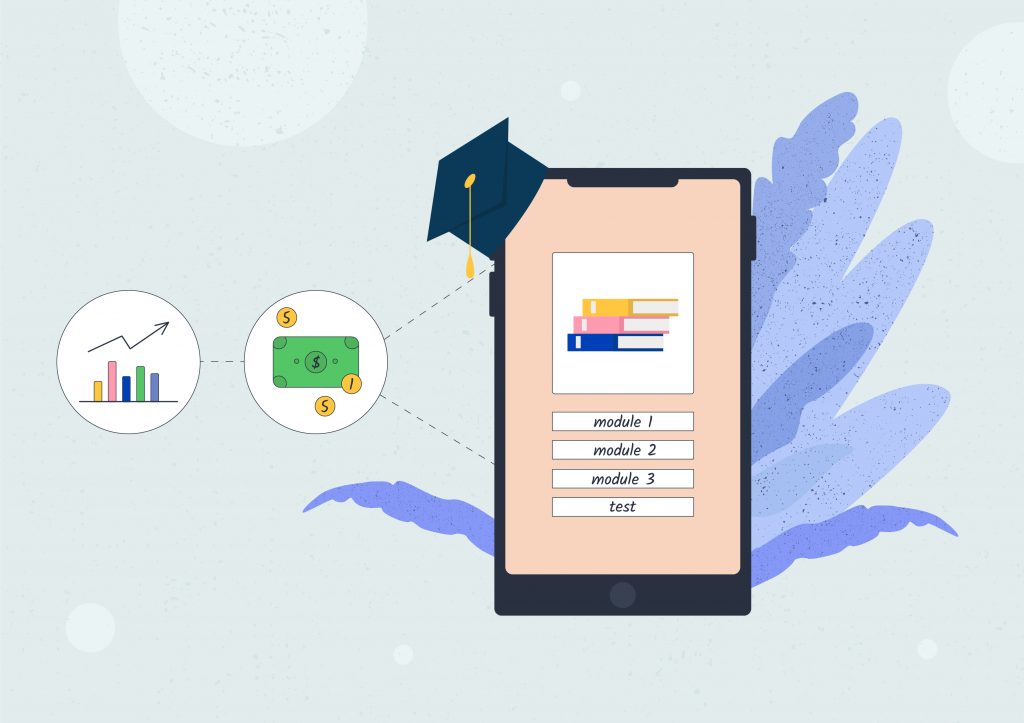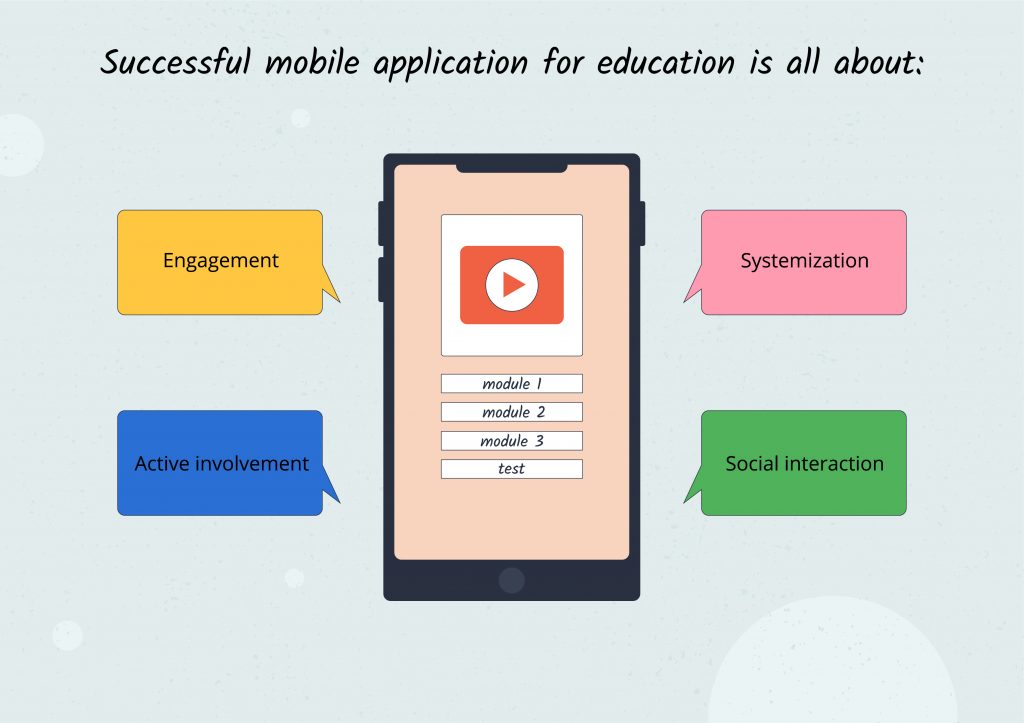Tips on Educational Mobile App Development

Education has always been essential for personal and career growth, but the fast rhythm of modern life does not always allow us to physically attend classes. Thanks to online education, however, people can now study almost anything at any time. In the past, when people wanted to learn Japanese, they would need costly books and preferably a native speaker to teach them. Nowadays, you can simply choose from a variety of special mobile apps. If you want something more serious, you can attend online courses provided by the world’s best universities and even get a certificate. There will always be people who prefer to study in the classroom, but online learning platforms and mobile apps empower educators to reach a much wider audience.
According to AppBrain, educational apps are the most popular category on Google Play as of May 2020. So now, especially considering the COVID-19 pandemic, educational mobile app development appears more relevant than ever before.
Building a mobile application for education requires not only the knowledge of the industry (the same goes for eCommerce, fitness, tourism, or any other market) but also of the psychology and even people’s stereotypes about education. The task is not only to build an app but to make the learning process engaging and motivational. So let’s start with the reasons.
The Advantages of a Mobile Application for Education
Apart from accessibility, an educational mobile application has the following benefits:
1. A mobile app allows learners to be flexible with their education. Although educational apps usually have a schedule of some sort, learners are still free to choose the time of the day when it is most convenient for them to proceed with the study. This way, their education becomes more regular and continuous.
2. Great efficiency thanks to gradual, incremental learning.
3. Low entry threshold; almost anyone can enjoy lifelong learning; the learners’ age, location, income level, and even some disabilities become less important. This can also mean wider audiences for educators and entrepreneurs.
4. Affordability; usually, the price of a mobile learning app is lower than the cost of attending correspondence courses offline.
5. Connecting people; most educational apps allow not only communication between students and teachers but also between students. That way, users can chat about interesting subjects with peers from around the world.
6. Users perceive learning through mobile apps not as a must-do but rather as an item on their hobby list. It works for everyone: adults can replace re-watching their favorite movies with learning, whereas kids and teens will prefer engaging apps to reading a book.
7. Achievement realization which spawns additional motivation. It is easier for learners to feel a sense of progress when an app has tracking, level up, and leaderboard features. Users know what they’ve already done, how well they performed, and what to do to beat their neighbor’s score next time.
These are the benefits for users, but what about entrepreneurs who are considering educational mobile app development? The most prominent are:
1. Improving staff knowledge and, therefore, qualifications. This can work for any learner and promotes the growth of any business.
2. Popularizing knowledge in a modern and creative way. Originally, books were a way to help expand the minds of people everywhere. Now it is time to expand that idea with some high-tech solutions.
3. Publishers can charge for downloads or subscriptions, or integrate in-app purchases for generating considerable revenue.
For example, the language-learning leader Duolingo proves that sticking to the noble mission of providing free education “is not only good for the world, but it’s also good for business.” The major secret to building a successful educational mobile app is to devise an effective online education business model.
Educational App Ideas to Consider
Educational app development largely depends on your business goals and the needs of your target audience. Some of the most popular categories of mobile apps are:
1. Online courses mobile apps. Users can choose from a great variety of courses — from scrapbooking to mobile app development.
For example, almost school-like Coursera and Udacity grant access to a vast base of courses from major universities with quizzes, homework, and exams. Whereas more free-form Skillshare and Masterclass are simpler, you can also do homework and can decide on sharing it with a community.
2. Mobile apps for language learning. People who are learning a language for professional reasons, for leisure, or to prepare for exams will surely find something to their liking. Such apps help to build a stronger vocabulary, learn new grammar nuances, and help to motivate on the way to full fluency.
Duolingo is a superb example. The app with a bright and intuitive user interface offers 94 language courses in 23 languages. To boost engagement, Duolingo uses a level structure which also creates competition-like experiences (leaderboards are included too). Users can also get a certificate they can add to their LinkedIn profile.
3. Memorizing or brain training mobile apps. These apps don’t even look like education at first glance but feel like skill-related games. Usually, they have a step-by-step learning routine (often in the form of levels) and daily tasks.
Elevate is an example. A bright user interface entices users to play beneficial games. There are games on writing, reading, speaking, listening, and math. All categories include game-like training quizzes that can be personalized. As the user moves on and shows excellent performance, new games lock. Semper, another app, also creates game-like challenges from which users gain actual knowledge, but its key idea is to feed users quizzes or mini-games when they unlock their phones.
4. Mobile apps for supporting education; these are various dictionaries, libraries, and daily planners. They provide significant support for students and improve their learning process.
EdPlus, which Alternative-spaces helped to develop for the Oxford University’s spinoff company, is just this type of app. The app is designed to help and motivate schoolchildren to learn outside the classroom. The program comprises small sessions in English, French, Spanish, Italian, German, Math, Science, and Geography. Initially, it was made for children aged 3 to 12 years, but anyone can use it.
Educational apps that help employees improve on-job performance also fall into this category. Companies should be careful not to share any sensitive or proprietary information in the app.
5. Mobile apps that help to prepare for exams; they comprise tests, teaching materials, and exam preparation materials. Some apps also have study management features, such as reminders and statistics, plus more advanced features including teacher communication interfaces.
6. Mobile apps that teach how to develop apps; these apps teach the basics of software development, programming languages, and coding. There is an app for almost every widespread programming language, and some apps teach more than one.
Let’s take Grasshopper as an example. The free Android and iOS app has a structure somewhat similar to Duolingo. It helps learners to get better at JavaScript by solving puzzles, and its achievements feature helps to keep learners motivated.
Educational Mobile App Development Tips
Enhanced product discovery can provide a sound foundation for a future educational mobile app. It’s important to build a clear vision of a future product and have a clever plan. It will help to estimate the scope of work, resources, and effort necessary for your educational app development.
The next step is to study your target audience. This implies answering the following questions:
1. Who will be interested in using your app? To answer this fully, you will need to consider the demographic data, such as age, location, gender, and so forth, plus other personal interests. If the app is being designed for corporate use, it is also useful to keep in mind the roles of employees that are targeted.
2. Why will the learners use your app? This one is more tricky since you have to determine what drives and motivates your target audience. Namely, their intrinsic motivation. This includes life and career goals, connected challenges, and even guessing their primary motivation.
3. What will they use your app for? It’s useful to create personalized learning programs. This will help to fill the knowledge gaps and strengthen weak spots.
4. Where will learners use your app? Clarify the usage context since the app content and its form should correspond to the circumstances in which it will be used. Let’s say your target audience uses a bus to get to work and it takes 15 minutes. Will it be possible for them to get through the ‘daily’ exercises while they are traveling to work? Will the bus noises interfere? Consider the circumstances, duration, and frequency.
5. How will learners use your app? This question is probably the hardest one because now is the time to think about the format your target audience will prefer. Will it be audio or visual content? This doesn’t necessarily mean you need to choose just one but you should select one that will prevail.
Regarding business models for educational apps, some recommendations are as follows:
- If you plan a paid app, ask yourself: would you buy the app you will sell? Competition should be taken into consideration: if your rival’s educational app is cheaper, users will most likely choose it over yours.
- Freemium seems like a better option since they can try a bit of what you have to offer and sample what they will pay for. The first trick is to offer just the right amount of free content and features to provide an encouraging app experience and entice users to want more. The second trick is determining the timing of the offer to purchase before the learner loses motivation to learn, people tend to be motivated by the money they spent on their courses, lessons, etc.
- In-app purchases may comprise various items, such as access to detailed statistics or a virtual amulet that allows skipping one day of training without losing their progress. The choice of items depends on the nature of your app, its target audience, and its approach to education itself (formal or informal, etc).
- In-app ads can be used too. But be careful to add them carefully: if they are too distracting and annoying, they can push your learners away.

Apart from these, learning apps offer unique ways to generate revenue, for example, through a partnership with an educational institution. App developers can either sell the product to such an institution or make an agreement that allows them to use their learning materials in the app.
The next step is to choose the platform. Will you target only one, or will your app be multi-platform? It is mostly a question of budget capabilities, so take your time to make a well-informed decision. If it is possible, it is better to hire separate teams of iOS and Android developers, that way you will have two separate native versions of an app for both platforms. Native apps are known for much better performance and user interface than any hybrid or cross-platform. If it’s not possible to hire two teams, effective tools for cross-platform development are there for you. For example, Flutter eliminates the need for separate Android and iOS app development and makes it possible to create an app for both platforms simultaneously.

In a world that changes faster and faster, easy access to education is becoming more vital. Knowledge is truly limitless and one can never study too much. This helps to make educational mobile applications a valuable and desirable player on the app playing field.
Alternative-spaces has broad experience in educational software and web development and counts learning mobile application development among its specializations. If you’re ready to create a unique educational journey for the world, please contact us. Together we can make that journey enjoyable!
Content created by our partner, Onix-systems.
 Home
Home